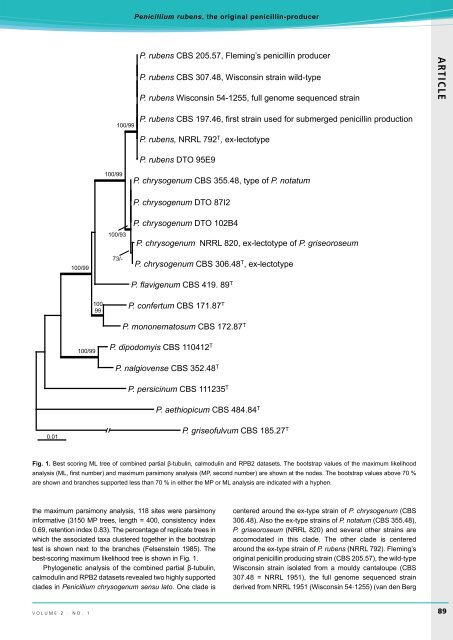Fleming's penicillin producing strain is not Penicillium - IMA Fungus
Fleming's penicillin producing strain is not Penicillium - IMA Fungus
Fleming's penicillin producing strain is not Penicillium - IMA Fungus
You also want an ePaper? Increase the reach of your titles
YUMPU automatically turns print PDFs into web optimized ePapers that Google loves.
Figure 1<br />
<strong>Penicillium</strong> rubens, the original <strong>penicillin</strong>-producer<br />
P. rubens CBS 205.57, Fleming’s <strong>penicillin</strong> producer<br />
P. rubens CBS 307.48, W<strong>is</strong>consin <strong>strain</strong> wild-type<br />
P. rubens W<strong>is</strong>consin 54-1255, full genome sequenced <strong>strain</strong><br />
ARTICLE<br />
100/99<br />
P. rubens CBS 197.46, first <strong>strain</strong> used for submerged <strong>penicillin</strong> production<br />
P. rubens, NRRL 792 T , ex-lectotype<br />
P. rubens DTO 95E9<br />
100/99<br />
P. chrysogenum CBS 355.48, type of P. <strong>not</strong>atum<br />
P. chrysogenum DTO 87I2<br />
100/99<br />
100/93<br />
73/-<br />
P. chrysogenum DTO 102B4<br />
P. chrysogenum NRRL 820, ex-lectotype of P. gr<strong>is</strong>eoroseum<br />
P. chrysogenum CBS 306.48 T , ex-lectotype<br />
P. flavigenum CBS 419. 89 T<br />
100<br />
99<br />
P. confertum CBS 171.87 T<br />
P. mononematosum CBS 172.87 T<br />
100/99<br />
P. dipodomy<strong>is</strong> CBS 110412 T<br />
P. nalgiovense CBS 352.48 T<br />
P. persicinum CBS 111235 T<br />
P. aethiopicum CBS 484.84 T<br />
0.01<br />
P. gr<strong>is</strong>eofulvum CBS 185.27 T<br />
Fig. 1. Best scoring ML tree of combined partial β-tubulin, calmodulin and RPB2 datasets. The bootstrap values of the maximum likelihood<br />
analys<strong>is</strong> (ML, first number) and maximum parsimony analys<strong>is</strong> (MP, second number) are shown at the nodes. The bootstrap values above 70 %<br />
are shown and branches supported less than 70 % in either the MP or ML analys<strong>is</strong> are indicated with a hyphen.<br />
the maximum parsimony analys<strong>is</strong>, 118 sites were parsimony<br />
informative (3150 MP trees, length = 400, cons<strong>is</strong>tency index<br />
0.69, retention index 0.83). The percentage of replicate trees in<br />
which the associated taxa clustered together in the bootstrap<br />
test <strong>is</strong> shown next to the branches (Felsenstein 1985). The<br />
best-scoring maximum likelihood tree <strong>is</strong> shown in Fig. 1.<br />
Phylogenetic analys<strong>is</strong> of the combined partial β-tubulin,<br />
calmodulin and RPB2 datasets revealed two highly supported<br />
clades in <strong>Penicillium</strong> chrysogenum sensu lato. One clade <strong>is</strong><br />
centered around the ex-type <strong>strain</strong> of P. chrysogenum (CBS<br />
306.48). Also the ex-type <strong>strain</strong>s of P. <strong>not</strong>atum (CBS 355.48),<br />
P. gr<strong>is</strong>eoroseum (NRRL 820) and several other <strong>strain</strong>s are<br />
accomodated in th<strong>is</strong> clade. The other clade <strong>is</strong> centered<br />
around the ex-type <strong>strain</strong> of P. rubens (NRRL 792). Fleming’s<br />
original <strong>penicillin</strong> <strong>producing</strong> <strong>strain</strong> (CBS 205.57), the wild‐type<br />
W<strong>is</strong>consin <strong>strain</strong> <strong>is</strong>olated from a mouldy cantaloupe (CBS<br />
307.48 = NRRL 1951), the full genome sequenced <strong>strain</strong><br />
derived from NRRL 1951 (W<strong>is</strong>consin 54‐1255) (van den Berg<br />
volume 2 · no. 1<br />
89
















